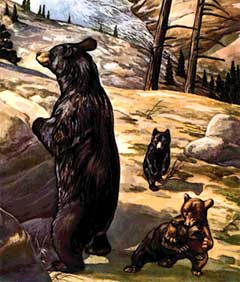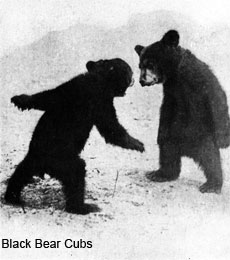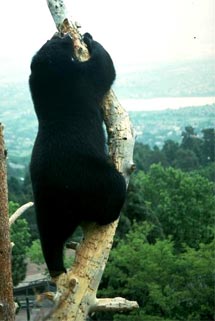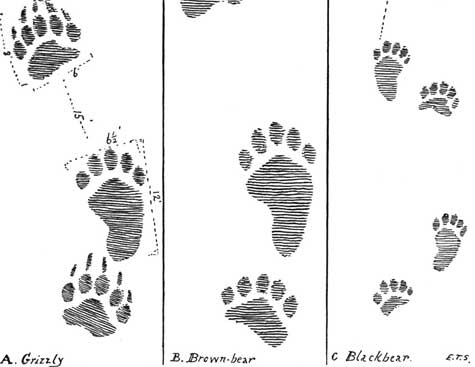|

Weights and Measures: The black bear is about 1.5 m (5 feet) long. Females weigh between 40 and 180 kg (90 and 400 pounds), while males weigh between 50 and 400 kg (110 and 880 pounds). Cubs usually weigh between 200 and 450 g (between seven ounces and one pound) at birth. The adult black bear has small eyes, rounded ears, a long snout, a large body, and a short tail. They have an excellent sense of smell.
  Perfect Posture: While black bears are able to stand and walk on their hind legs, they usually stand or walk on all four legs. (When they do stand it usually is to get a better look at something.) Perfect Posture: While black bears are able to stand and walk on their hind legs, they usually stand or walk on all four legs. (When they do stand it usually is to get a better look at something.)
The Black Bear Shuffle:
The black bear's characteristic shuffle results from walking flat-footed, with the hind legs slightly longer than the front legs. Each paw has five strong claws used for tearing, digging, and climbing. One blow from a powerful front paw is enough to kill an adult elk.
Home is Where You Have
Your Habitat:
Black bears prefer forested and shrubby areas but use wet meadows, high tidelands, ridgetops, burned areas, riparian areas, and avalanche chutes. They also frequent swampy hardwood and conifer forests. After emerging from their winter dens in spring, they seek southerly slopes at lower elevations for forage and move to northerly and easterly slopes at higher elevations as summer progresses.
Black bears use dense cover for hiding and thermal protection, as well as for bedding. They climb trees to escape danger and use forested areas as travel corridors. Black bears hibernate during winter and may build dens in tree cavities, under logs, rocks, in banks, caves, or culverts, and in shallow depressions.
On the Menu: Black bears are omnivores. They eat a wide variety of foods, relying most heavily on grasses, herbs, fruits, and mast. They also feed on carrion and insects such as
* carpenter ants (Campanotus spp.)
* yellow jackets (Vespula spp.)
* bees (Apidae)
* termites (Isoptera).
Don't Play Dead! Black bears sometimes kill and eat small rodents and ungulate fawns. Unlike the brown bear, black bears like to attack and eat dead creatures, which makes humans feigning death at bear attacks ineffective. Like many animals, black bears seldom attack unless cornered or threatened. They are less likely to attack man than grizzly bears and typically have long since run for cover before one catches sight of them. Black bear predation on man is extremely rare. It is estimated that there have been only 56 documented killings of humans by black bears in North America in the past 100 years

To implant, or not to implant... Black bears reach breeding maturity at about 4 or 5 years of age, and breed every 2 to 3 years. Black bears breed in the spring, usually in May and June, but the embryos do not begin to develop until the mother dens in the fall to hibernate through the winter months (delayed implantation.) However, if food was scarce and the mother has not gained enough fat to sustain herself during hibernation as well as produce cubs, the embryos do not implant (develop).
 Winter Babies: Black bear cubs are generally born in January or February. They are blind when born, and twins are most common, though up to four cubs is not unheard of and first-time mothers typically have only a single cub. By spring thaw, when the bears start leaving their dens, the cubs are fur-balls of energy, inquisitive and playful. Winter Babies: Black bear cubs are generally born in January or February. They are blind when born, and twins are most common, though up to four cubs is not unheard of and first-time mothers typically have only a single cub. By spring thaw, when the bears start leaving their dens, the cubs are fur-balls of energy, inquisitive and playful.
When their mother senses danger she grunts to the cubs to climb high up a tree. They are weaned between July and September of their first year, and stay
with the mother through the first winter. They are usually independent by the second winter.
Cub survival is totally dependent on the skill of the mother in teaching her cubs what to eat, where and how to forage (find food), where to den, and when and where to seek shelter from heat or danger.

Misunderstood: Because their behavior has been little understood until recently, black bears have been feared and hated. Before the 20th century these bears were shot intermittently as vermin, food, and trophies being seen as either a vicious beast or an endless commodity; in many areas, bounties were paid, until recently, for black bears. The British Queen's Foot Guard's hat has been for centuries made of black bear fur, and its original name is bearskin.
 Ain't No Teddy Bear: Paradoxically, black bears have also been portrayed as harmless and cuddly. For example, the teddy bear owes its existence to a young black bear cub Theodore Roosevelt refused to shoot. Today, black bears are as much an important game species as they are a point of debate across the continent, especially when it comes to the fact that many are finding life in the suburbs quite comfortable. Given their relatively low reproductive rate, black bear hunting must be carefully controlled and is probably inappropriate in areas where populations are feeble or where habitat is no longer intact. Ain't No Teddy Bear: Paradoxically, black bears have also been portrayed as harmless and cuddly. For example, the teddy bear owes its existence to a young black bear cub Theodore Roosevelt refused to shoot. Today, black bears are as much an important game species as they are a point of debate across the continent, especially when it comes to the fact that many are finding life in the suburbs quite comfortable. Given their relatively low reproductive rate, black bear hunting must be carefully controlled and is probably inappropriate in areas where populations are feeble or where habitat is no longer intact.
Bears and Humans: Their tendencies to follow their stomachs and habitat encroachment by humans have created human-bear conflicts. This is true especially in areas where they may have been uncommon or absent for a long time, as in many parts of the eastern United States. An excellent example is the state of New Jersey. In New Jersey, bears were quite uncommon before the modern era as much land was cleared for homes and farming and also due to poor policies regarding hunting and forestry; by 1970 there were only 100 bears extant.
However, due to changes in land usage, management, and population increases in neighboring Pennsylvania and New York, that number increased to nearly 1500 bears by 2003. The result is that the residents of this densely populous state sometimes awaken to find the garbage ripped to shreds or a birdfeeder knocked to the ground at best, and at worst a bear invading the home or attacking. (Invasion usually happens after a bear has lost its fear and has come to associate people with food and attacks occur when a human gets in the way of said food.) This is a cause for concern among civilians and scientists alike. Similar events have unfolded in other states and in Canada, and state, provincial and federal agencies are working to address the issue with trap and release programs, limited hunting, and hazing bears with rubber bullets, other aversion techniques, and dogs. In agricultural areas electric fences have been very effective.

All text is available under the terms
of the GNU Free Documentation License
|